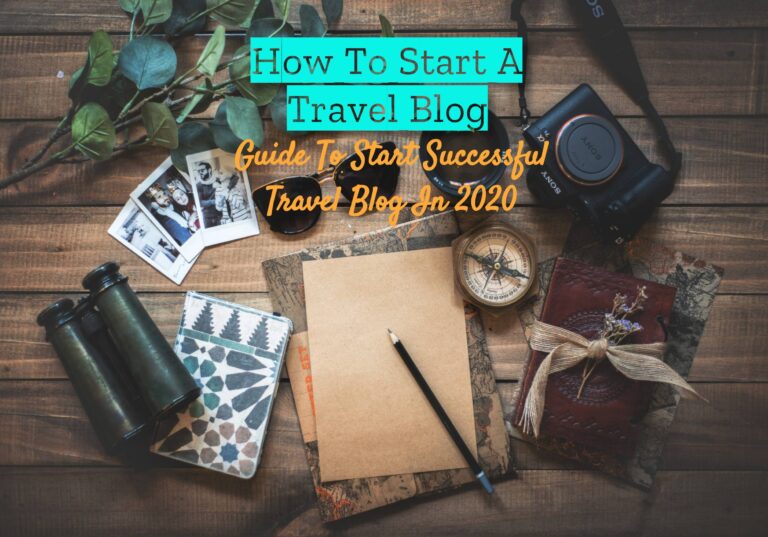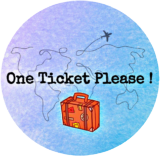How to Start a Travel Blog
Guide to start a successful travel Blog in 2021

There was a time when we used to write journals and pen down our memories. Moving forward, blogging replaced handwritten journals and gave people a platform to share their views. This may be a hobby for many but some turned it into a profession and are working their way up. To start a travel blog and setting up the pages appears pretty easy. The reason being that these things are quick to do with almost no effort. But if you are opting for a blogging career(either a side-business or full-time) you need to be precise and definite with your vision.
Reason to Blog


There should be a core reason to start working as a blogger. Most of the people lack this perspective and can not continue with what they initiated. I believe that you are not among these people and have thought this through already. (The probable reason why you end up on this blog!) As of the travel blogging world, let me warn you- it is a crowded place. To stand out here, all you need to do is be genuine and rational. You have to put in the efforts but you are not alone. Here I am to introduce you to every aspect of travel blogging.
With an understanding that you have a blogger’s mindset, let us jump into the process of creating a fabulous travel website for you. To be honest, starting a blog page is at ease these days, thanks to WordPress. Otherwise, you would be dealing with a web designer right now. So without any further ado, let me take you through this step by step instructions, by the end of which you will be completely acknowledged with creating a travel website.
To make a remarkable travel blog, you need to get the below-mentioned steps perfectly done. You should make a brief note of what you have to do to get started.
- Decide a Name
- Sign-Up for a Host
- Install WordPress
- Learn the WordPress Dashboard Basics
STEP 1: DECIDE A NAME For Travel Blog
This is the very first thing you need to think of. Picking up a domain name for your website can be quite brainstorming. Because this is how people will recognize you and your blogs for a lifetime. There isn’t any compulsion about what the website should be named but there is a better way to approach this.



1. Keep it Short and Simple:
The shorter, the better. Now, don’t get too funky with the domain name. Make sure to use 3-4 words or at most 5 words. This will make it easy for people to remember your travel blog. Avoid hyphen or use of punctuation in between the words. This just makes it hard to read. Put up a name that describes you the most in a very simple way. This helps you to connect with your readers.
2. A Name That Lasts :
The mistake most of the bloggers make is that they choose a name that restricts their reach after a particular time or place. Say, you named it “Twenty-something…” or “Dave’s Australian Journeys”, you have already set a condition. What about when you travel outside Australia? How will you mention that in the blogs? Moreover, are you going to stop traveling after your twenties? Such names will hold you back. So, pick up a name that will not stop you from exploring new things.
3. Avoid Repetitive Words :
When it comes to travel, words like nomad, wanderlust, or adventurer come to our mind first. Stay away from such words. These words are like a dead language when it comes to naming your website. You should avoid them and think of something original. Do not confuse people with the name. It should just click on them as they read it. Using these repetitive words will give the impression that you probably copied the name.
4. Keep It Classy
Keeping a long-term vision, your domain name has to be high-class. If in case you end up working with travel agencies or other companies, the name will stand out as your first impression. This will make it even harder for you to earn from your blogs. There will be a lesser chance of you being selected by companies to collaborate with. So, keep the name classy and presentable.
STEP 2: Travel Blog Needs A HOST!!
After putting our head together in the domain name, it is time for you to sign up for hosting. In the most basic sense, choosing a host means that you are buying some space to stack up your blogs and all the website related files. To your surprise, there is an ocean full of web hosting companies that provide you with these services. But not each one of them meets all your needs. Apart from a space on the server, there are several other things to consider while you buy hosting. The bandwidth offered by a hosting company along with the privacy protection and database support must be top-notch.
Selecting the Best Host
Talking of this, Bluehost is by far the most frequently used and trusted web hosting. It has the best of features at affordable prices all year round. Yes, to be clear, hosting purchase is going to cost you but that is reasonable and much needed if you want to take your travel blog to a professional level.
For those who don’t know about hosting, this may be quite overwhelming but it is not that scary as you think. It takes almost 10 minutes to get the hosting— it is that easy. For those who are new to blogging, they must not spend much right from the start. Try to build some traffic and then spend accordingly. However, if you had a site earlier and have experience in this, you can opt for premium choices.
The next thing to do is land on our hosting website, i.e. Bluehost. To Sign-up, you should click on the “get started” button and you will be redirected to a page with all the hosting packages. Once again, the basic package is for beginners(you can always upgrade later) and those with experience can opt for other options. The great news here is that you get the hosting with an almost 60% discount on prices. The price cuts off to $2.95 from $7.99 per month. Furthermore, you get your domain name free for one year.
Setting Up the Domain Name
After you select the plan, it is now time to set up your domain name. There will be two dialogue boxes. One asking to create a domain name and the other one for writing your existing domain. If this is the first time you are making a domain then fill in the first box you can skip the next box. After you complete this process, fill in the details and process the payment. Take note of what you select in the amount plan. I will recommend selecting the 36 months plan which will cost you just $2.95 per month. Moreover, you don’t need to worry about renewing plans for a long time.
Finally, you are good to go! The domain name and hosting are all set and you are ready to create your travel website. Wasn’t that easy?! Since you are done with this step, let’s move onto the next procedure and introduce you to WordPress.
STEP 3: INSTALL WORDPRESS To Operate Travel Blog
The completion of the Bluehost purchase will take 5 minutes and you will be asked to create your WordPress password. The latest version of WordPress will be installed automatically. If you are wondering what WordPress is, then it is where you will create and build your site. All the customization related to the site is done here. You will manage all your content with the help of WordPress.
When you have set your password, Bluehost will ask you to select the theme for your blog. There is no hard and fast rule for this. You can change the theme whenever you want and pick another one. You also have an option to skip this here and choose any WordPress theme later. There are a few more recommendations that Bluehost gives you. You can work on them as per your preference.
Furthermore, there will be an option to select the type of website you are creating. Is it for business purposes for personal- you get to select this? If you are planning for the travel business, then click on business otherwise personal.
You are then asked to launch your website by mentioning the website name and slogan/description. You can add the slogan later on using WordPress also. The site is launched after asking you 2-3 things. The option for the welcome page and whether to have WooCommerce will be put in front of you. If you aren’t sure about it now, then click on “not now” and look for these options later on.
Congratulations! You are now the owner of this WordPress travel blog. All the tricky part is done and now you can customize your site to new looks. Before diving right into content creation and managing things, you need to know the basics of WordPress. I am not kidding when I say that the WordPress window kinda scared me when I first looked at it. So, to make you familiar with how WordPress works, the next step is to guide through the WordPress Dashboard. This will definitely get your basics cleared.
STEP 4: LEARN HOW THE WORDPRESS DASHBOARD WORKS
To learn about WordPress, you need to first log in to your website. Go on to http://yourdomainname.com/wp-admin (mention the domain name you chose here). You will be asked the username and password to log in. After that, you will be directed to a WordPress window from where you will handle your travel website. Now that you have access to the WordPress Admin Dashboard, come take a look at everything that is mentioned there.
WordPress will help you to manage your content, add plugins that help your website function properly, and offer enticing themes to style your website. The following are the options you will see under the dashboard. Get yourself acknowledged with them for the smooth use of WordPress.
To the left side, you will see:
1. Dashboard Menu :
When you install the Jetpack plugin, the dashboard menu appears with options like set up, settings, backup and scan, Modules, and Debugging centers. These options allow you to protect your site from bot logins and any other spamming. Moreover, you can change the custom settings through this menu.
2. Posts :
Moving downwards, there you will see an option of Posts. By clicking on this, you will be able to write and edit your posts. You can see all your blogs here. The categories and tags for the blog posts can be created here.
3. Media :
All the photos and videos that are on your website are stored here. You can add new photos to the gallery. You get to see the media library here and can add new media content.
4. Pages :
As you start to build your website, you need to create pages like contact us, about page, legal pages(privacy policy, T&C, etc.). They are the individual landing pages of your website apart from the Homepage. These pages can be added to the site by selecting the new page option. After that, you can style and edit these pages according to the theme of the website.
5. Comments :
The comments on your blog post will appear here. You can view them and keep a check on the spam folder so that no real comments go there. You can decide what comments will be seen publicly and hide others.
6. Updates :
This is where you will get updates about your website. Whenever a new version of any plugin pops up or the new WordPress update will show here. You should keep everything updated so that your site runs well.
7. Appearance
Your travel website will be customized using appearance. Right from the themes, widgets, header and footer, and the page templates; you will be provided with every option here. You can change the page design and even personalize your travel blog theme.
8. Plugin :
This is an important section. With the help of plugins, you can make your website more efficient and give it an outstanding look. You can even review and update your installed plugins here.
9. Settings :
To handle all the settings of the website, you can select this option. A page will appear where all the required changes can be made.
10. Insights :
To track the performance of your website, insights are very crucial. The stats about the views, comments and the number of visitors will be tracked here. Although, a better choice for statistical tracking will be Google Analytics.
11. Tools and WP Forms :
The tools option is a helping hand when it comes to site designing. Apart from that, the WP Forms are the contact-form plugin. You can add the contact section to your website or blog pages with these and get in touch with your viewers.
This was all about the WordPress Dashboard basics. I hope you understood the above-mentioned steps. It seems a little overwhelming at first. Everything is new, you are not familiar with the terms and therefore it seems difficult at first. But believe me, you will get used to this dashboard after using it 3-4 times.
Being said that, the process of creating a travel blog does not end here. There is more to the blogging arena. These were the first few steps as to how you should get your website launched. The building and customization of the website is still an untouched topic here. To learn more about the theme selection and making your website look professional, read the next blog: “Setting Up Your Travel Blog Website”
